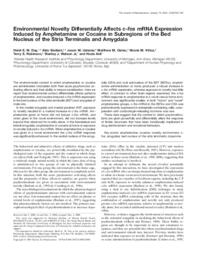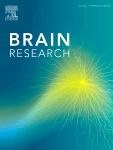Badiani, Aldo
Person Preferred Name
Aldo Badiani
Related Works
Content type
Digital Document
Abstract
The environmental context in which amphetamine or cocaine are administered modulates both their acute psychomotor activating effects and their ability to induce sensitization. Here we report that environmental context differentially affects patterns of amphetamine- and cocaine-induced c-fos mRNA expression in the bed nucleus of the stria terminalis (BST) and amygdala of male rats.
In the medial amygdala and medial posterior BST, exposure to novelty resulted in a marked increase in c-fos mRNA. Amphetamine given at home did not induce c-fos mRNA, and when given in the novel environment, did not increase levels beyond that observed for novelty alone. In the basolateral and lateral amygdala, amphetamine or cocaine at home or exposure to novelty induced c-fosmRNA. When amphetamine or cocaine was given in a novel environment the c-fos mRNA response was significantly enhanced. In the central nucleus of the amygdala (CEA) and oval subnucleus of the BST (BSTov), amphetamine administration at home produced a robust increase in c-fos mRNA expression, whereas exposure to novelty had little effect. In contrast to other brain regions examined, the c-fos mRNA response to amphetamine in a novel versus home environment was significantly smaller. In both “home” and “novel” amphetamine groups, c-fos mRNA in the BSTov and CEA was predominantly expressed in enkephalin-containing cells; coexpression with corticotropin-releasing hormone was rare.
These data suggest that the context in which psychostimulants are given powerfully and differentially alters the response of limbic structures that have been functionally implicated in drug reinforcement and emotional behaviors.
Origin Information
Content type
Digital Document
Abstract
The mesostriatal dopamine (DA) system is known to play a vital role in extrapyramidal motor responses, and animals with a unilateral 6-hydroxydopamine (6-OHDA) lesion of this system have proved useful in studying the behavioral and neurobiological effects of DA depletion. Less is known about the role of this system in modulating emotional responses, although a number of lines of evidence suggest that dopamine influences emotional behavior. During the course of a study involving rats that had a unilateral 6-OHDA lesion, we discovered a hemispheric asymmetry in the levels of corticotropin releasing hormone (CRH) mRNA in the central nucleus of the amygdala (CEA). The present study was performed in order to determine (1) if the lesion resulted in a decrease in CRH mRNA, and/or if there was upregulation on the intact side, (2) if a similar imbalance in CRH mRNA was observed in other brain regions and (3) if levels of other neuropeptide mRNAs were affected by the lesion. Adult male Sprague–Dawley rats were left unoperated or were pretreated with desipramine and then injected unilaterally with 6-OHDA into the medial forebrain bundle to lesion the ascending mesostriatal DA neurons. Animals were killed 15–31 days following surgery and brain sections processed for CRH, neurotensin and enkephalin mRNAs by in situ hybridization. Levels of CRH and neurotensin mRNAs were decreased on the lesioned side in the CEA and oval nucleus of the BST (BSTov) relative to the intact side and to unoperated controls. Levels of enkephalin mRNA in these regions were not affected by the lesion. These effects appeared specific, because the lesion did not alter CRH mRNA expression in the ventral BST, paraventricular nucleus of the hypothalamus or cortex or neurotensin mRNA expression in the CA1 region of the hippocampus. In contrast, and consistent with previous reports, levels of neurotensin and enkephalin mRNAs were upregulated on the lesioned side of the striatum. This study provides evidence that the mesostriatal DA system regulates CRH and neurotensin mRNA in the BSTov and CEA, suggesting that dopamine may be an important modulator of CRH and neurotensin function within these nuclei. Although the precise mechanisms are not clear, and the involvement of noradrenergic systems cannot be precluded, data are consistent with the idea that dopamine, released in response to a stressful experience for example, interacts with CRH and neurotensin in the extended amygdala to affect emotional responsiveness.
Origin Information


